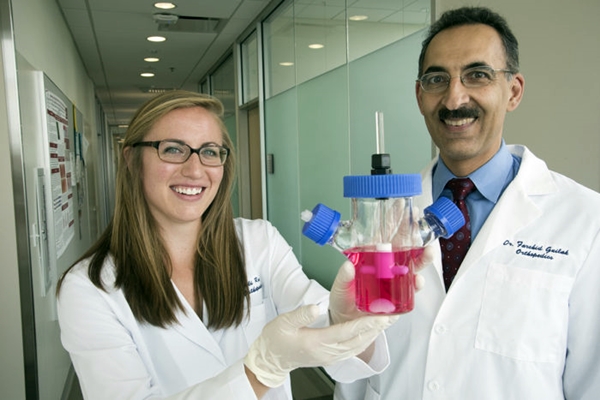
Farshid Guilak, right, and co-author Alison Ross show prototype of living hip replacement (Robert Boston, Washington University in St. Louis)
19 July 2016. A process combining stem cells, industrial weaving, and gene therapy to grow replacement joint cartilage for osteoarthritis is shown in lab tests to also prevent inflammation from returning. A team from Washington University in St. Louis and biomaterials company Cytex Therapeutics in Durham, North Carolina demonstrate their technology in yesterday’s issue of Proceedings of the National Academy of Sciences (paid subscription required).
Researchers from the lab of orthopedic surgery professor Farshid Guilak at Washington University’s medical school are seeking better ways to treat osteoarthritis, the most common form of arthritis, affecting some 27 million people in the U.S. Symptoms often appear gradually and become worse with age, but are aggravated by overuse, obesity, previous injuries, and in some cases genetics. Treatments for osteoarthritis usually aim at relieving pain, since no cure is yet found.
While osteoarthritis affects mainly older individuals, it can occur in people as young as 25. The techniques developed by Guilak and colleagues are designed primarily for younger people with the condition, for whom normal joint replacement surgery would be a temporary solution, since replacement joints do not last more than 20 years. Another replacement surgery runs risks of bone damage and infection.
In their paper, the team created a synthetic, hip ball joint made from poly-epsilon-caprolactone, or PCL, fibers, a long-lasting biocompatible polymer. The fibers are woven into 3-D hemispheric scaffolds, about 22 millimeters in diameter, with the structure and properties of cartilage using industrial weaving techniques adapted by Cytex Therapeutics. Cytex is a spin-off enterprise from Duke University in Durham; Guilak is also president of Cytex and formerly a faculty member at Duke.
The fiber scaffolds are then seeded with stem cells derived from adipose or fat tissue from the patient, thus removing the risk for immune rejection. The stem cells are cultured and induced to develop into cartilage, which can replace the patient’s damaged cartilage.
The researchers took the process one step further. The team also coated the PCL fibers with Interleukin-1 Receptor Antagonist or IL-1Ra genes, using benign viruses to deliver the genes, which were transferred into the stem cells. IL-1Ra genes have anti-inflammatory properties blocking signals from Interleukin-1 proteins that promote inflammation.
In lab tests, the team tested identical synthetic cartilage samples treated with Il-1 proteins. The cartilage sample without IL-1Ra genes expressed inflammatory enzymes, while the cartilage receiving the IL-1Ra genes did not produce those enzymes.
“We’ve developed a way to resurface an arthritic joint using a patient’s own stem cells to grow new cartilage,” says Guilak in a university statement, “combined with gene therapy to release anti-inflammatory molecules to keep arthritis at bay. Our hope is to prevent, or at least delay, a standard metal and plastic prosthetic joint replacement.”
The researchers say they began tests of the technology with lab animals, and expect human clinical trials could start in 3 to 5 years.
Read more:
- Engineered Facial Bone Grown from Stem Cells
- Patent Awarded for Skin Stem Cell Regeneration Methods
- FDA Approves Trial Testing Stem Cells for Brain Injuries
- Challenge Seeks New Regenerative Tools with Stem Cells
- Stem Cell Biotech Licensing Blood Vessel Repair Technology
* * *

 RSS - Posts
RSS - Posts
[…] Stem Cells, Gene Therapy Produce Replacement Joint Cartilage […]